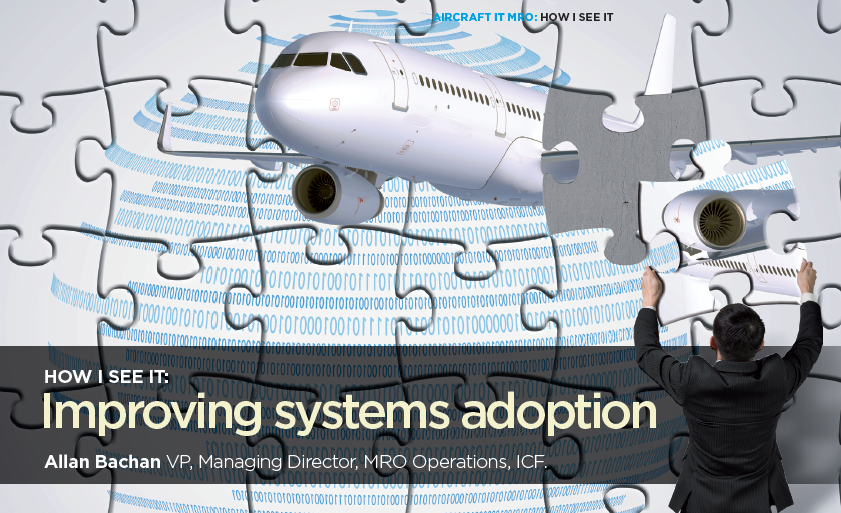Articles
| Name | Author | |
|---|---|---|
| How I see IT – Improving systems adoption | Allan Bachan VP, Managing Director, MRO Operations, ICF. | View article |
| Case Study: Better technology supports better lease returns at Jazz Aviation | John Hensel, Manager Business Services Portfolio, Jazz Aviation | View article |
| Case Study: Coopesa goes from effective to efficient | Walter Ching, Director Operations / COO, Coopesa R.L. | View article |
How I see IT – Improving systems adoption
Author: Allan Bachan VP, Managing Director, MRO Operations, ICF.
Subscribe
Improving systems adoption
Recently, over lunch, I was talking with a close friend about experiences with a new MRO IT system which his company had implemented just over four years ago. It was interesting to note that there was no brimming excitement in his voice at any of the ‘wonderful things’ they had since achieved. This, mind you, is the same individual who managed one key workstream (of many) with a team of eight during the implementation. He was then full of zeal and energy for what was ahead. I had in fact developed the business case to justify the project spend using some of his valuable inputs at that time.
He said that in just three months after go-live, the project team was formally disbanded, and everyone was absorbed back into the operations. There was no formal structure for continuous improvement, change management and adoption. He believes that the system is now only forty percent utilized after all that time.
I wonder how many M&E and MRO organizations are in that same situation?
It reminds me of when I first got into aviation maintenance in the nineteen eighties. In Technical Records, we updated aircraft utilization and maintenance events in hard cover Aircraft Logbooks; created a forecast of inspections and component removals from Kardex cards; and, every day, filed away hundreds of pages of Work Orders and compliance documents in cabinets and boxes.
There was an MRO computer system which was installed more than three years before I joined. Only one ‘terminal’ for the mainframe was in the Technical Records office and all six Records resources shared this ‘terminal’. The only tasks done on that machine were to input aircraft flight times for eighteen aircraft and updating letter check accomplishments. This same system was also in use at a few US majors and managing a combined fleet of more than six hundred aircraft at the time. No Kardex.
Hmmm… Less than ten percent of the system – judging from the total ‘transactions’ available – was in use after almost three and a half years. That was thirty-two years ago.
I made a commitment and formed a team. In six months, the Kardex cards were gone and our use of the computer system was up by fifty percent. Needless to say, our efficiency and productivity were increased and all our internal ‘customers’ realized big gains in their organizations: more real-time and decision support information was readily available on their desktops, in the hangars, at the line stations and in the shops. The biggest gains were in the Maintenance Planning and Reliability Management functions.
So, every company has a story to tell. What’s yours? Have you explored everything in your MRO IT toolkit? What are you refusing to let go? What do you not understand? Who else are you involving?
Not all performance improvement initiatives and mechanisms need a physical entity within the organization to function properly. As a matter of fact, it is more of a mindset. Like Emergency Response Teams and Reliability Committees within Technical Operations; there can be assigned roles, with defined communication protocols and dedicated tools which contribute to a Center of Excellence or a Competence Center. It is a level of awareness and consciousness which is fully acknowledged and embedded into your fabric of managing daily operations and objectives.
MRO IT management must be seen as a core piece of the Technical Operations toolkit. It is not uncommon to see this overly delegated to IT departments which focus on status quo as it would with any other software. For far too long, maintenance organizations have been just living – not thriving – with their supporting IT systems. Essentially applying Band-Aids as issues arise.
Perhaps it is time to take a comprehensive look at all your MRO business processes and how they are enabled with your technology tools. Identify what you have not adopted very well and aggressively pursue the opportunities to optimize.
For now, that how I see IT.
Simplify
your choice. Book a free consultancy session with Allan
to discuss the issues here, in greater detail and in the context of your
business and challenges.
Contributor’s Details
Allan Bachan

Allan is a Vice President at ICF with 32 years of industry experience as an Aviation M&E, MRO and Supply Chain solutions and systems domain expert. He is responsible for ICF’s MRO Operations and IT practice and he manages the Aircraft Commerce Consulting relationship with ICF. His experience includes managing application design, development, and full cycle implementation – from selection to go-live – for strategic clients in the MRO industry using different commercially available MRO IT products. In his career, Allan has fulfilled the following leadership roles: MRO IT practice and technical lead; MRO systems Product Principal; M&E and MRO Solutions Director and Manager of Technical Records, Maintenance Planning and Production Control.
Comments (0)
There are currently no comments about this article.

To post a comment, please login or subscribe.